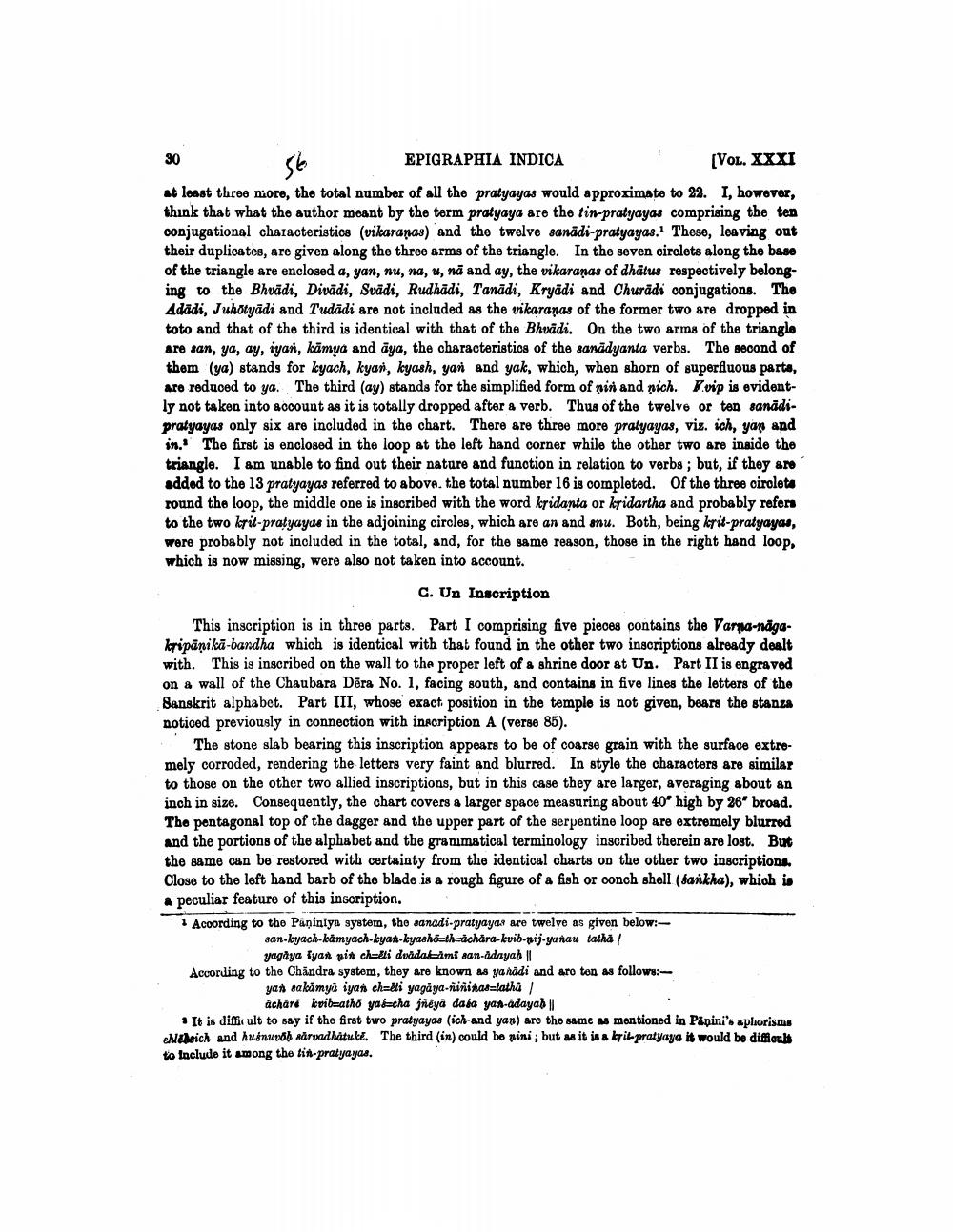________________
56
EPIGRAPHIA INDICA
[VOL. XXXI
at least three miore, the total number of all the pratyayas would approximate to 22. I, however, think that what the author meant by the term pratyaya are the tin-pratyayas comprising the ten conjugational characteristics (vikaranas) and the twelve sanadi-pratyayas.1 These, leaving out their duplicates, are given along the three arms of the triangle. In the seven circlets along the base of the triangle are enclosed a, yan, nu, na, u, na and ay, the vikaranas of dhatus respectively belonging to the Bhvadi, Divādi, Svādi, Rudhādi, Tanadi, Kryadi and Churadi conjugations. The Adadi, Juhōtyādi and Tudadi are not included as the vikaranas of the former two are dropped in toto and that of the third is identical with that of the Bhvadi. On the two arms of the triangle are san, ya, ay, iyan, kamya and aya, the characteristics of the sanadyanta verbs. The second of them (ya) stands for kyach, kyan, kyash, yan and yak, which, when shorn of superfluous parts, are reduced to ya. The third (ay) stands for the simplified form of nin and nich. vip is evidently not taken into account as it is totally dropped after a verb. Thus of the twelve or ten sanādipratyayas only six are included in the chart. There are three more pratyayas, viz. ich, yan and in. The first is enclosed in the loop at the left hand corner while the other two are inside the triangle. I am unable to find out their nature and function in relation to verbs; but, if they are added to the 13 pratyayas referred to above. the total number 16 is completed. Of the three circleta round the loop, the middle one is inscribed with the word kridanta or kridartha and probably refers to the two krit-pratyayas in the adjoining circles, which are an and snu. Both, being krit-pratyayas, were probably not included in the total, and, for the same reason, those in the right hand loop, which is now missing, were also not taken into account.
C. Un Inscription
This inscription is in three parts. Part I comprising five pieces contains the Varṇa-nāgakripānika-bandha which is identical with that found in the other two inscriptions already dealt with. This is inscribed on the wall to the proper left of a shrine door at Un. Part II is engraved on a wall of the Chaubara Dera No. 1, facing south, and contains in five lines the letters of the Sanskrit alphabet. Part III, whose exact position in the temple is not given, bears the stanza noticed previously in connection with inscription A (verse 85).
30
The stone slab bearing this inscription appears to be of coarse grain with the surface extremely corroded, rendering the letters very faint and blurred. In style the characters are similar to those on the other two allied inscriptions, but in this case they are larger, averaging about an inch in size. Consequently, the chart covers a larger space measuring about 40" high by 26" broad. The pentagonal top of the dagger and the upper part of the serpentine loop are extremely blurred and the portions of the alphabet and the grammatical terminology inscribed therein are lost. But the same can be restored with certainty from the identical charts on the other two inscriptions. Close to the left hand barb of the blade is a rough figure of a fish or conch shell (sankha), which is a peculiar feature of this inscription.
According to the Paniniya system, the sanadi-pratyayas are twelve as given below:san-kyach-kamyach-kyan-kyasho-th-achara-kvib-pij-yanau tatha !
yagaya iyan pin chili dvadasami san-adayah ||
According to the Chandra system, they are known as yahadi and are ten as follows:
yan sakāmyā iyan challi yagaya-ñiñinas-tathu |
áchäre kvib-atho ya cha jñeya daba yan-adayab ||
It is difficult to say if the first two pratyayas (ich and yan) are the same as mentioned in Papini's aphorisms chlebeich and husnuvōb särvadhatuke. The third (in) could be aini; but as it is a krit-pratyaya it would be difficult to Include it among the tin-pratyayas.




